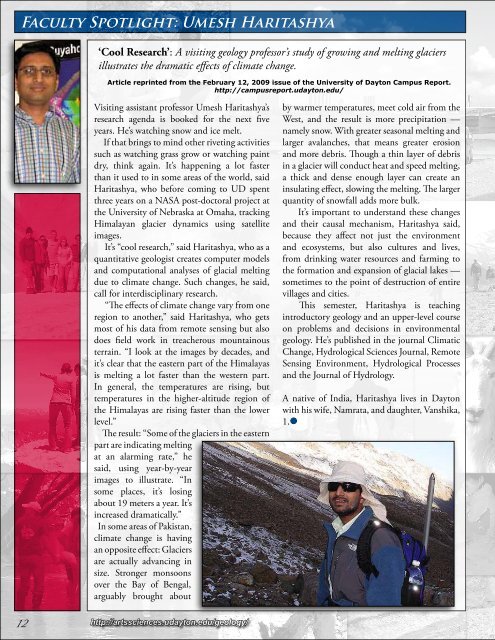View this issue (pdf) - University of Dayton
View this issue (pdf) - University of Dayton
View this issue (pdf) - University of Dayton
Create successful ePaper yourself
Turn your PDF publications into a flip-book with our unique Google optimized e-Paper software.
Faculty Spotlight: Umesh Haritashya<br />
‘Cool Research’: A visiting geology pr<strong>of</strong>essor’s study <strong>of</strong> growing and melting glaciers<br />
illustrates the dramatic effects <strong>of</strong> climate change.<br />
Article reprinted from the February 12, 2009 <strong>issue</strong> <strong>of</strong> the <strong>University</strong> <strong>of</strong> <strong>Dayton</strong> Campus Report.<br />
http://campusreport.udayton.edu/<br />
Visiting assistant pr<strong>of</strong>essor Umesh Haritashya’s<br />
research agenda is booked for the next five<br />
years. He’s watching snow and ice melt.<br />
If that brings to mind other riveting activities<br />
such as watching grass grow or watching paint<br />
dry, think again. It’s happening a lot faster<br />
than it used to in some areas <strong>of</strong> the world, said<br />
Haritashya, who before coming to UD spent<br />
three years on a NASA post-doctoral project at<br />
the <strong>University</strong> <strong>of</strong> Nebraska at Omaha, tracking<br />
Himalayan glacier dynamics using satellite<br />
images.<br />
It’s “cool research,” said Haritashya, who as a<br />
quantitative geologist creates computer models<br />
and computational analyses <strong>of</strong> glacial melting<br />
due to climate change. Such changes, he said,<br />
call for interdisciplinary research.<br />
“The effects <strong>of</strong> climate change vary from one<br />
region to another,” said Haritashya, who gets<br />
most <strong>of</strong> his data from remote sensing but also<br />
does field work in treacherous mountainous<br />
terrain. “I look at the images by decades, and<br />
it’s clear that the eastern part <strong>of</strong> the Himalayas<br />
is melting a lot faster than the western part.<br />
In general, the temperatures are rising, but<br />
temperatures in the higher-altitude region <strong>of</strong><br />
the Himalayas are rising faster than the lower<br />
level.”<br />
The result: “Some <strong>of</strong> the glaciers in the eastern<br />
part are indicating melting<br />
at an alarming rate,” he<br />
said, using year-by-year<br />
images to illustrate. “In<br />
some places, it’s losing<br />
about 19 meters a year. It’s<br />
increased dramatically.”<br />
In some areas <strong>of</strong> Pakistan,<br />
climate change is having<br />
an opposite effect: Glaciers<br />
are actually advancing in<br />
size. Stronger monsoons<br />
over the Bay <strong>of</strong> Bengal,<br />
arguably brought about<br />
by warmer temperatures, meet cold air from the<br />
West, and the result is more precipitation —<br />
namely snow. With greater seasonal melting and<br />
larger avalanches, that means greater erosion<br />
and more debris. Though a thin layer <strong>of</strong> debris<br />
in a glacier will conduct heat and speed melting,<br />
a thick and dense enough layer can create an<br />
insulating effect, slowing the melting. The larger<br />
quantity <strong>of</strong> snowfall adds more bulk.<br />
It’s important to understand these changes<br />
and their causal mechanism, Haritashya said,<br />
because they affect not just the environment<br />
and ecosystems, but also cultures and lives,<br />
from drinking water resources and farming to<br />
the formation and expansion <strong>of</strong> glacial lakes —<br />
sometimes to the point <strong>of</strong> destruction <strong>of</strong> entire<br />
villages and cities.<br />
This semester, Haritashya is teaching<br />
introductory geology and an upper-level course<br />
on problems and decisions in environmental<br />
geology. He’s published in the journal Climatic<br />
Change, Hydrological Sciences Journal, Remote<br />
Sensing Environment, Hydrological Processes<br />
and the Journal <strong>of</strong> Hydrology.<br />
A native <strong>of</strong> India, Haritashya lives in <strong>Dayton</strong><br />
with his wife, Namrata, and daughter, Vanshika,<br />
1.<br />
12<br />
http://artssciences.udayton.edu/geology/
















